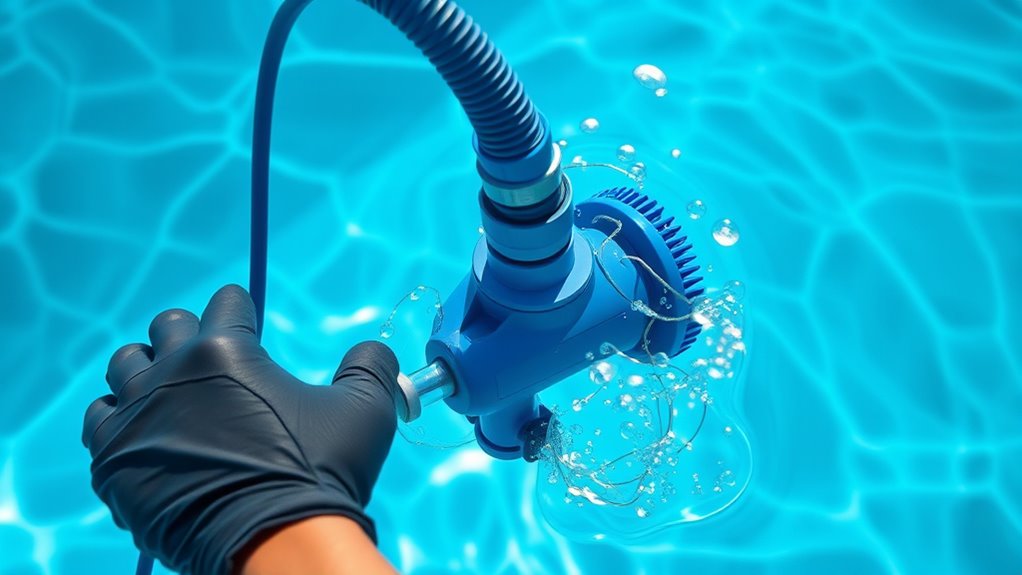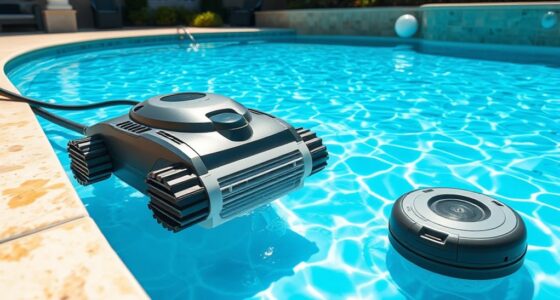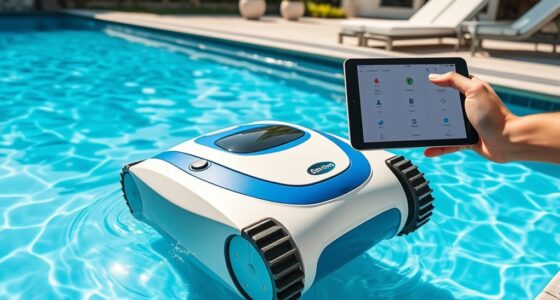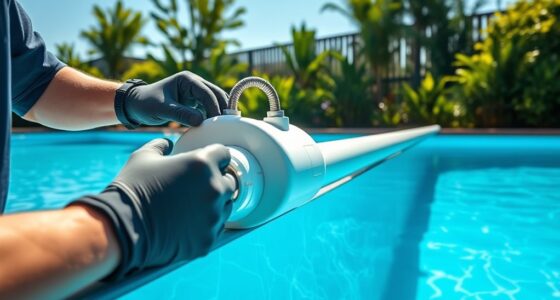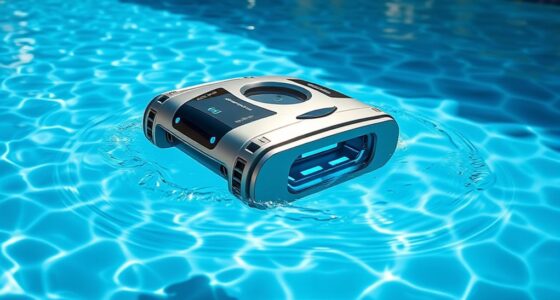To troubleshoot your pressure pool cleaner, start by checking the power supply and connections to guarantee everything’s secure and the breaker hasn’t tripped. Inspect and clean the nozzles, jets, hoses, and filters to remove blockages or debris. Verify water flow and pressure levels, adjusting as needed. Also, examine the cleaner’s movement and track alignment for smooth operation. If issues persist, you can explore more tips to keep your cleaner working efficiently.
Key Takeaways
- Check that the main power supply, circuit breaker, and all electrical connections are secure and functioning correctly.
- Inspect hoses, fittings, and nozzles for leaks, blockages, or damage, and clean or replace as needed.
- Ensure water flow system components are clear of debris and properly connected to maintain adequate pressure.
- Verify track alignment and cleaner movement to confirm smooth operation and proper coverage.
- Regularly clean debris bags, filters, and water flow parts to prevent flow restrictions and maintain optimal performance.
Checking the Power Supply and Connections
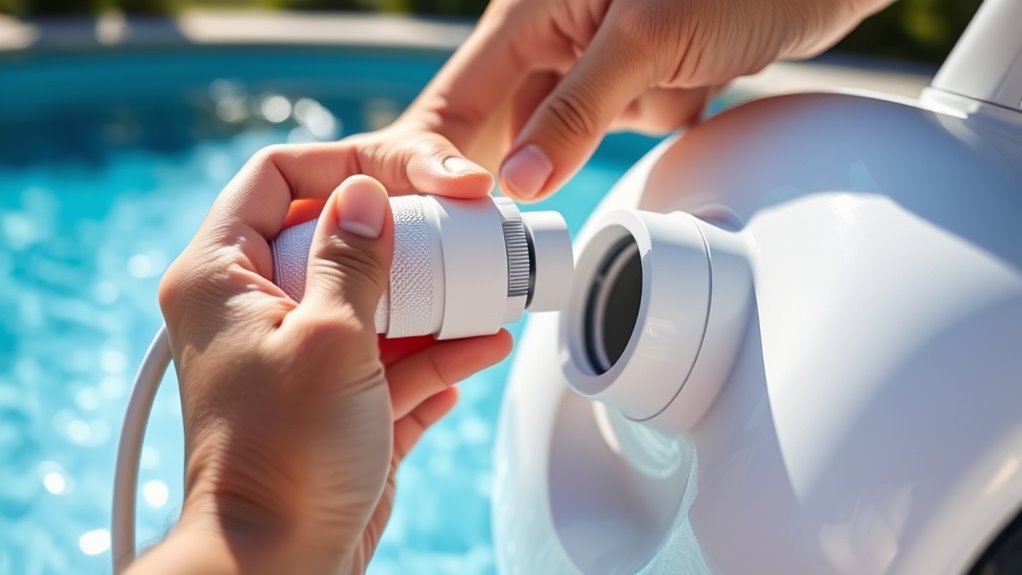
Have you checked if the pool cleaner’s power supply is working properly? A power outage could be the culprit, so start by confirming your home’s main power is on. Next, inspect the circuit breaker dedicated to the pool equipment. Sometimes, it trips unexpectedly, cutting off power to your cleaner. Flip the breaker off and then back on to reset it. Ensure all connections between the power source and the cleaner are secure. Loose or damaged cords can prevent the cleaner from functioning. If everything seems in order but the device still isn’t working, consider testing the outlet with another device to confirm it’s delivering power. Addressing these basic issues early saves time and prevents unnecessary repairs. Additionally, power supply stability is crucial for consistent operation of your pressure pool cleaner. Regularly checking your electrical connections can help maintain equipment performance and avoid future malfunctions. Incorporating preventative electrical maintenance can further enhance reliability and extend your equipment’s lifespan.
Inspecting and Cleaning the Nozzles and Jets
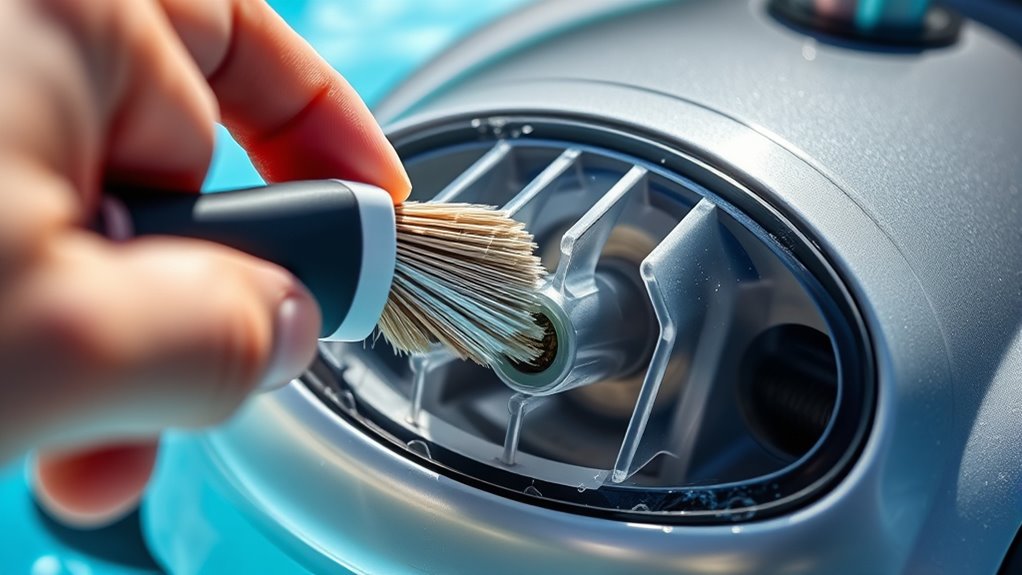
If your pool cleaner isn’t working properly, check the nozzles and jets for blockages. Remove any debris or mineral buildup that could be be obstructing water flow. You can clean the jets with a brush or soak them in vinegar to restore proper function. Additionally, inspecting for clogged nozzles can help prevent future malfunctions and ensure optimal cleaning performance. Regular maintenance of the nozzle and jet system can also extend the lifespan of your pool cleaner. Using hydrocolloid technology in some pool accessories can help absorb impurities and improve overall efficiency. Performing routine checks aligns with proper pool maintenance practices to keep your equipment functioning smoothly. Properly maintaining the water flow system is essential for consistent cleaning results and preventing costly repairs.
Nozzle Blockages and Removal
Blocked nozzles and jets can considerably hinder your pool cleaner’s performance, so inspecting them regularly is essential. Start by checking the nozzle design, as some models have specialized shapes that can trap debris more easily. Remove the nozzles carefully, paying attention to how they fit back in, and examine the nozzle material—plastic, rubber, or metal—for buildup or damage. Use a small brush or toothpick to clear any debris lodged in the openings. If you notice cracks or warping, replacing the nozzle is necessary for critical operation. Regular cleaning prevents blockages that reduce water flow and cleaning efficiency. Ensuring the nozzles are free of obstructions helps maintain proper pressure and keeps your pool cleaner functioning smoothly. Additionally, inspecting for clogged or damaged jets regularly helps prevent water flow issues that impact cleaning performance. Recognizing and addressing narcissistic traits in your maintenance routine can help you stay consistent and attentive to your pool’s needs, much like how automation technologies in other industries require consistent oversight to operate optimally. Proper maintenance of nozzles and jets ensures optimal water flow, which is crucial for effective pool cleaning.
Jet Cleaning Techniques
Regularly inspecting and cleaning the nozzles and jets is essential to keep your pool cleaner operating effectively. Over time, debris and mineral deposits can clog these components, reducing water flow and cleaning performance. Before cleaning, verify your pool’s chemical balance is proper, as imbalanced chemicals can cause buildup inside jets. Also, check the pool water temperature, since warmer water can accelerate mineral deposits. To clean, remove the nozzles and jets carefully, then rinse them with water. Use a small brush or toothpick to clear any blockages gently. Reassemble the parts securely to prevent leaks. Maintaining clear nozzles and jets ensures ideal water pressure and movement, which improves your pool cleaner’s efficiency and prolongs its lifespan. Additionally, understanding the symptoms of clogging or malfunction can help you identify when cleaning or maintenance is needed before performance declines. Regularly inspecting water flow patterns can also help detect early signs of obstruction or issues with the jets. Incorporating knowledge of sound vibrations and their effects on components may assist in identifying subtle issues with jet operation.
Examining the Hoses for Leaks or Blockages
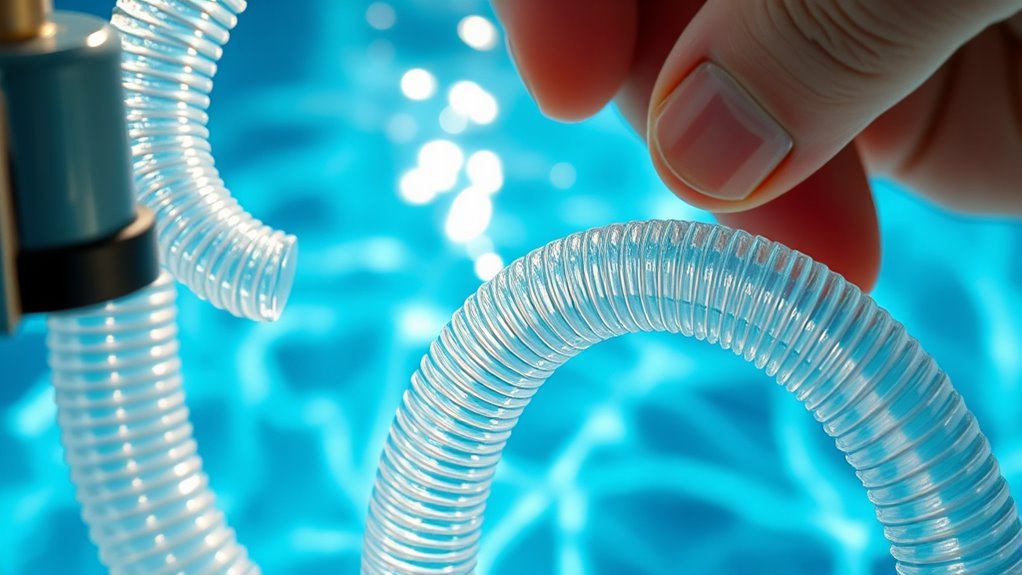
Start by inspecting the hoses for any visible cracks or damage that could cause leaks. Next, check for blockages or obstructions in the openings that might restrict water flow. Finally, verify all hose connections are secure and tight to maintain proper pressure. Additionally, ensure that the regulatory compliance related to pool equipment standards are met to prevent potential issues. Regularly inspecting hoses can also help identify early signs of wear and tear, which is essential for preventive maintenance. Incorporating advanced inspection techniques, such as using a flashlight or mirror, can assist in detecting subtle damages that might otherwise be overlooked. Being attentive to these details can help maintain optimal performance and prolong the lifespan of your pressure pool cleaner. Also, consider the importance of water circulation in ensuring the cleaner functions effectively, as poor circulation can lead to inefficiencies.
Inspect for Visible Cracks
Have you checked your pool cleaner’s hoses for cracks recently? Crack detection is essential to ensure your pressure cleaner operates smoothly. Begin with a thorough visual inspection, examining every inch of the hoses carefully. Look for any visible cracks, splits, or brittleness that could cause leaks or pressure loss. Pay close attention to areas near fittings or bends, where stress often occurs. Small cracks might be hard to spot but can still impact performance. If you find any cracks or signs of wear, consider replacing the damaged sections before continuing. Proper crack detection helps prevent further issues and keeps your pool cleaner functioning efficiently. Regular inspections save time and money by catching problems early.
Check for Blocked Openings
After inspecting your hoses for cracks, the next step is to check for blocked openings or leaks that could hinder your pool cleaner’s performance. Blocked openings often result from debris buildup, which can restrict water flow and reduce cleaning efficiency. Carefully examine each hose for any obstructions, such as leaves, algae, or dirt lodged inside. Use your fingers or a soft brush to clear away debris from the openings. Also, look for any leaks or cracks that might cause a drop in water pressure. Ensuring all openings are clear and free of debris helps maintain proper water flow, which is essential for your pool cleaner to operate effectively. Proper maintenance of the water flow system and keeping it free from blockages can prevent performance issues caused by blockages or leaks. Regularly inspecting and cleaning these components can also extend the lifespan of your pressure pool cleaner. Taking these steps can prevent performance issues caused by blockages or leaks.
Test Hose Connections
To guarantee your hose connections are functioning properly, you should carefully examine each connection point for leaks or blockages. Start by inspecting the hose fittings, ensuring they are securely attached and free of cracks or damage. Look for any signs of water leakage around the fittings, which could indicate loose or compromised connections. Next, check the hoses for blockages that might restrict water flow, such as debris or kinks. If you notice any issues, disconnect the hoses and clean or replace them as needed. Confirm connection stability by firmly reattaching all fittings, making sure they’re tight but not overly forced. Properly secured and clear hoses help maintain pressure and ensure your pool cleaner operates efficiently.
Ensuring Proper Water Flow and Pressure Levels
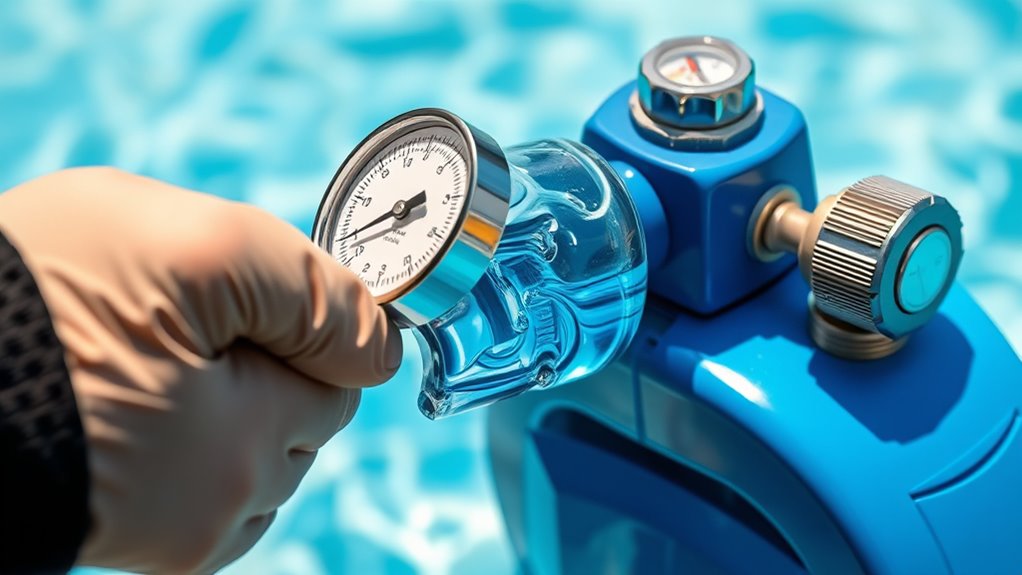
Maintaining proper water flow and pressure levels is essential for your pool cleaner to operate efficiently. If flow or pressure drops, your cleaner may stall or miss areas. To enhance performance:
- Check that your pool’s water chemistry, including pool chemicals, is balanced, as imbalances can affect flow.
- Ensure water temperature isn’t too low, which can thicken water and reduce circulation.
- Inspect the skimmer and pump baskets for debris that could restrict flow.
- Adjust the pressure regulator if your system allows, maintaining ideal pressure for your cleaner’s model.
Consistently monitoring these factors helps prevent pressure issues and keeps your cleaner functioning smoothly, providing a clean pool with less hassle.
Verifying the Cleaner’s Movement and Track Alignment
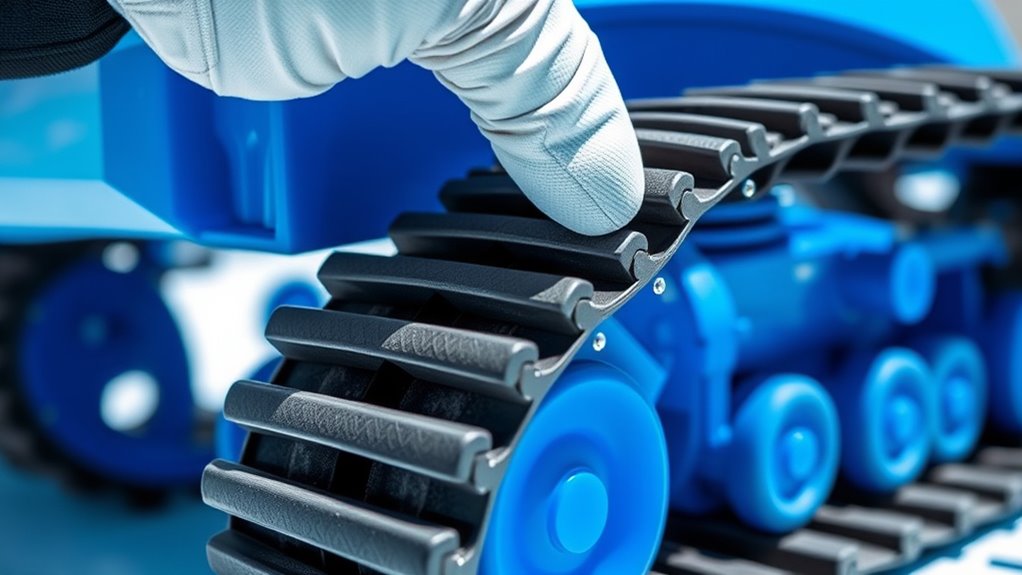
If your pressure pool cleaner isn’t moving smoothly across the pool floor, it’s essential to verify its movement and track alignment. Start by observing how it navigates the pool—look for inconsistent or uneven movement. Check the track alignment to ensure the tracks are properly seated and not slipping off the wheels or guides. Misaligned tracks can cause the cleaner to get stuck or miss areas. To perform movement verification, gently move the cleaner and see if it glides smoothly in all directions. If you notice resistance or irregular motion, re-align the tracks and ensure they are tight but not overly so. Proper track alignment and accurate movement verification help your cleaner perform efficiently, covering the entire pool surface thoroughly.
Cleaning or Replacing the Filter or Debris Bag
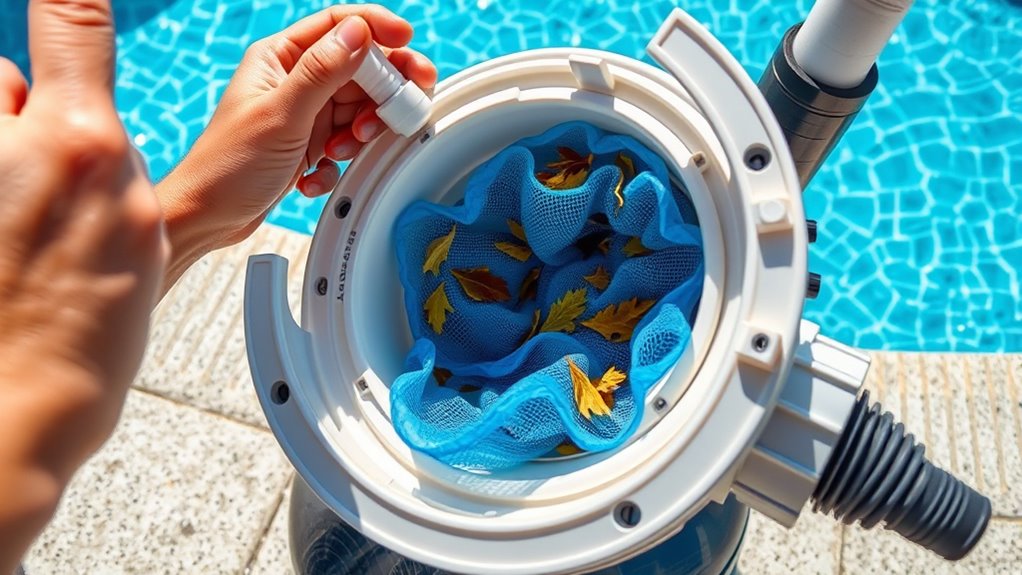
Over time, debris and dirt can clog the cleaner’s filter or debris bag, reducing its suction power and overall performance. To restore efficiency, you need to perform regular filter maintenance and debris removal. Start by turning off the cleaner and disconnecting it from the pool. Then, follow these steps:
Regularly clean the filter and debris bag to maintain optimal cleaner performance and suction power.
- Remove the debris bag or filter cartridge carefully.
- Shake out or rinse off debris using a hose, ensuring all particles are removed.
- Inspect for tears or damage; replace if necessary.
- Reassemble the filter or debris bag securely before reconnecting the cleaner.
Keeping the filter clean prevents clogs, maintains ideal flow, and ensures your pressure pool cleaner operates smoothly. Regular filter maintenance is the key to prolonging its lifespan and performance.
Assessing the Pressure Regulator and Valve Settings
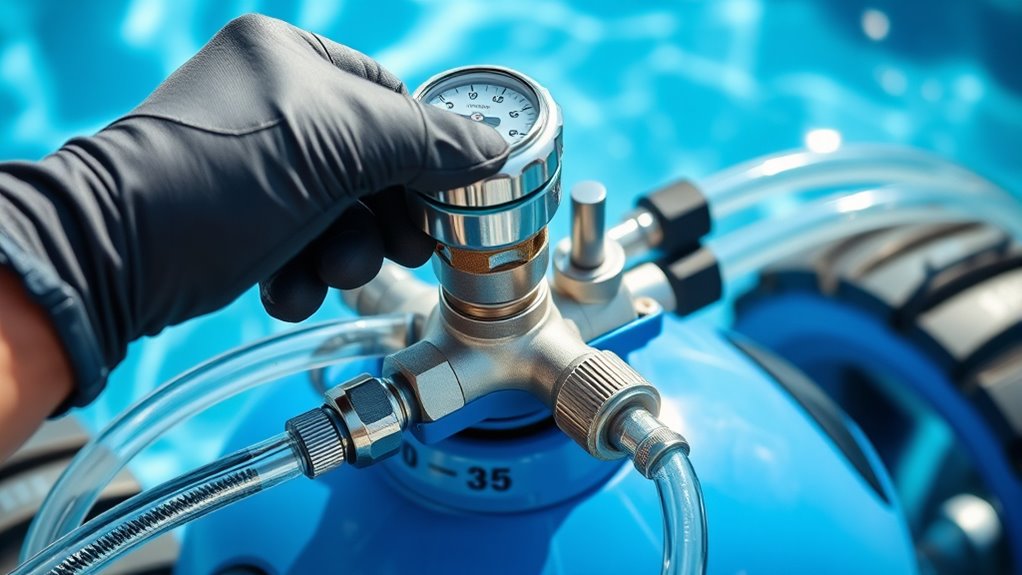
Have you checked the pressure regulator and valve settings lately? Proper water pressure is essential for your pool cleaner’s efficiency. Start by inspecting the valve adjustment; incorrect settings can reduce water flow, affecting cleaning performance. To help, here’s a quick guide:
| Issue | Check | Solution |
|---|---|---|
| Low water pressure | Valve too closed | Open valve gradually |
| Excessive pressure | Valve too open | Slightly close valve |
| Inconsistent flow | Blocked or misaligned valve | Adjust or clean valve |
Ensure the pressure regulator isn’t clogged or damaged. Adjust the valve based on your pool cleaner’s recommended water pressure, usually indicated on the unit. Proper valve adjustment improves flow and cleaning effectiveness.
Identifying and Fixing Any Obstructions in the Skimmer or Intake
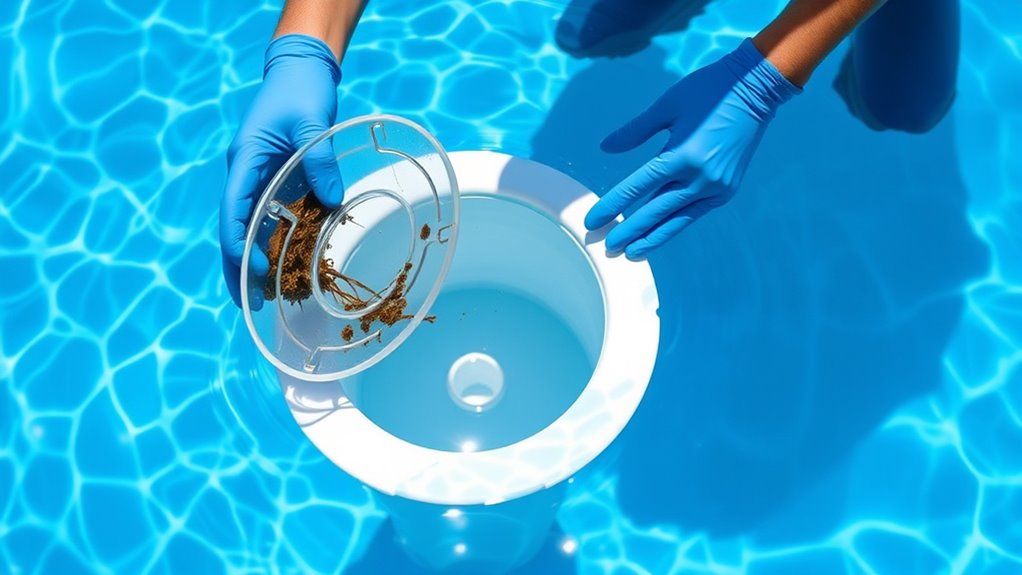
Obstructions in the skimmer or intake can substantially hinder your pool cleaner’s performance. Start by turning off the pump and removing the skimmer basket. Check for debris buildup that might block water flow. Next, inspect the skimmer opening and intake for leaves, twigs, or other debris. If you notice a clog, clear it out carefully. Then, examine the hoses for obstructions or kinks that could restrict water flow. Finally, ensure the skimmer basket is clean and properly seated, as a dirty basket can cause poor suction. Regularly maintaining and clearing obstructions will keep your pressure pool cleaner operating efficiently and prevent unnecessary strain on its components.
Testing for Wear and Damage on the Cleaner’s Components
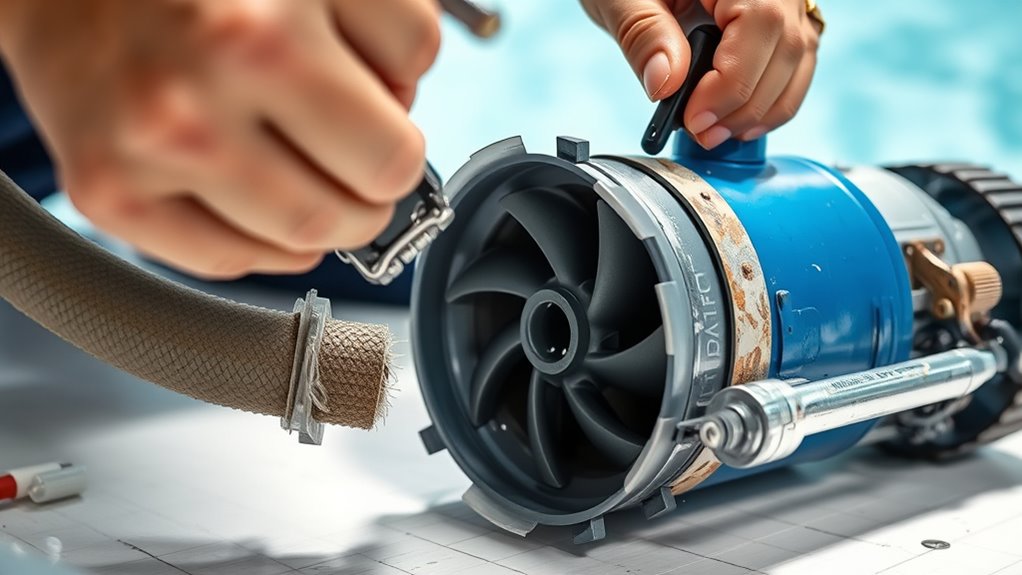
Regularly inspecting your pool cleaner’s components for signs of wear or damage is essential to keep it functioning effectively. Check the hoses, brushes, and wheels for cracks, tears, or signs of deterioration. Look for worn-out parts that may need replacement. Ensure that all component lubrication points are adequately greased to prevent friction and wear. Examine electrical wiring for any frays, corrosion, or loose connections that could cause malfunctions. Damaged wiring can lead to electrical failures, so replace or repair as needed. Pay close attention to the impeller and pump assembly, as wear here can reduce suction power. By regularly testing these areas, you can catch issues early, prolong your cleaner’s lifespan, and maintain peak cleaning performance.
Frequently Asked Questions
Why Does My Pressure Pool Cleaner Make Unusual Noises During Operation?
Your pressure pool cleaner may make unusual noises during operation if there’s a clog or debris in the pool filter. This can cause strain on the cleaner, resulting in strange sounds. Regular pool maintenance, including cleaning or replacing the pool filter, helps prevent this issue. Check for obstructions and confirm the filter is working properly to keep your cleaner running smoothly and quietly during pool cleaning sessions.
How Can I Reset My Pressure Pool Cleaner if It Stops Working?
Resetting your pressure pool cleaner is like giving it a fresh start. First, turn off the pool filter and unplug the cleaner. Check for any blockages in the water flow, like leaves or debris, and clear them out. Then, reconnect everything, turn on your pool filter, and restart the cleaner. This should reset the system and get your cleaner working smoothly again by restoring proper water flow.
What Are Common Signs of a Malfunctioning Pressure Regulator?
If your pressure regulator malfunctions, look for common signs like pressure gauge issues, where the gauge shows inconsistent or no readings, indicating a problem. You might also notice regulator leaks, which can cause pressure drops or water escaping around the regulator. These signs suggest the regulator isn’t functioning properly, so checking for leaks or gauge problems can help you identify and address the issue quickly.
How Do I Troubleshoot if the Cleaner Is Not Climbing the Pool Walls?
If your cleaner isn’t climbing the pool walls, start by checking for pool wall adhesion problems. Make sure the cleaner’s brushes and wheels are clean and free of debris. Next, examine suction flow issues—ensure the skimmer and pump baskets are clear, and the hoses aren’t clogged. Adjust the hose length or pressure settings if needed. These steps help improve wall climbing and overall cleaning performance.
What Steps Should I Take if the Cleaner’s Track Is Slipping or Not Gripping Properly?
If your pressure pool cleaner’s track slips or doesn’t grip well, start with track adjustment. Check if the track is properly aligned and tighten any loose components. For grip enhancement, inspect the rubber wheels and replace them if they’re worn out. Clean any debris on the track and wheels to improve traction. Properly adjusting the track and enhancing grip will help your cleaner move smoothly and efficiently around the pool.
Conclusion
Remember, a pressure pool cleaner is like a faithful guardian of your pool’s purity. When issues arise, troubleshooting is your key to unfastening smooth operation, much like tuning a finely crafted instrument. Stay attentive to each part, and you’ll keep your cleaner running like a well-oiled machine. With patience and care, you’ll guarantee your pool stays pristine—your ultimate oasis—ready to refresh and rejuvenate every time you plunge in.
